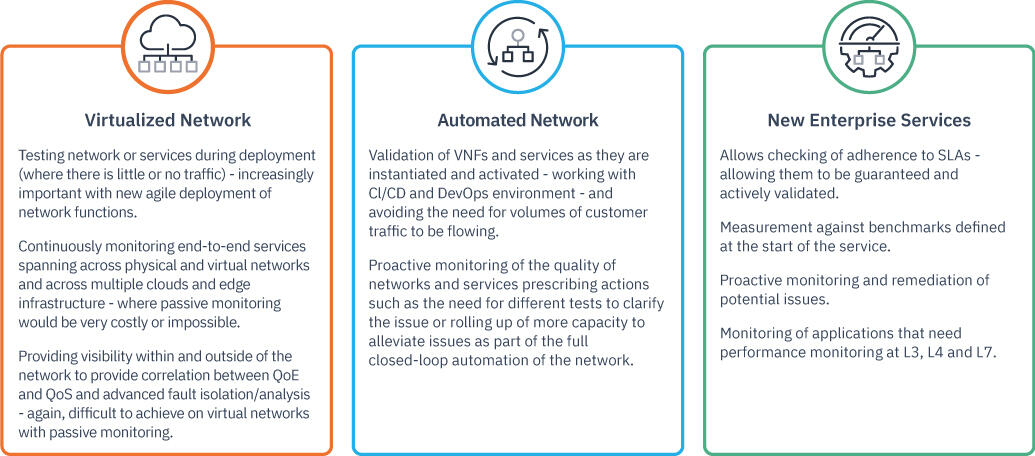There has been a significant rise in interest in active testing as 5G continues to be rolled out – with the identification of the difficulty that passive techniques face in virtualized networks, and the implications that has on the feasibility of delivering advanced services.
In this post we look at some examples of the critical role that active testing plays in the delivery of advanced connectivity, through active assurance, by combining passive and active monitoring with advanced troubleshooting and analytics.
Passive traffic monitoring systems:
- Require customers (and traffic) on the network in order to visualize performance – and thus while critical for monitoring, are less suitable for understanding issues in the early stages of virtual network function and service deployment;
- Provide insights into available capacity and resource utilization for current services delivered over the network, and the additional capacity available for new services, but don’t provide direct insight into the likely performance of services designed to use that capacity, before they’re launched into the live network;
- Can’t alone provide end-to-end troubleshooting across multiple domains and when the issue may be in cloud or edge infrastructure.
How does active assurance help?
Virtualized networks lend themselves to use of more active assurance, which was previously a costly activity only used in specific situations to monitor specific key services. It complements passive assurance which remains well-designed for monitoring and finding major issues at key points in the network – providing a range of benefits:

How can active testing help with assurance of new enterprise services with specific requirements?
Considering the final box of the diagram above, active assurance provides crucial detection, troubleshooting and validation capabilities in support of taking to market, and then operating, advanced telco services (particularly those that rely on SLA compliance for enterprise customers). It also allows for assurance of services with particular features which require capabilities not available from passive monitoring.
Monitoring of critical services
Where lives and businesses rely on “always on” networks – for example, public safety networks, home security systems, or utility remote management it is necessary for performance to remain at a high level across all networks and infrastructure. Active testing can test each line on a regular basis or continuously monitor to pick up even minor fluctuations and isolate / troubleshoot problems. This is possible, crucially, even if there is no live traffic passing through the network, which is a common scenario in critical networks, that are used for emergency situations, rather than on a continuous basis.
Monitoring of services with non-standard or intermittent traffic flows
Services which provide critical insight into a major failure (such as IoT sensors in a utility network) may, similarly, only generate very low volumes of traffic or need to report when a potential problem is identified. Without regular traffic volumes for passive monitoring, active testing is required to ensure that the service or application is unaffected by network performance issues.
Monitoring of all customers using a service
Testing of every single user within an enterprise customer that uses a particular service using passive monitoring becomes difficult as testing may be required across multiple networks. If the enterprise customer requires this type of rigorous monitoring, active testing can benchmark service quality levels, prioritize troubleshooting by notifying the enterprise what services, devices or network elements are causing issues and how many of their users are affected.
Monitor high-performance services
Active testing allows for more granular understanding of performance issues – providing microsecond-level visibility of network and infrastructure performance across multiple networks. This will be increasingly useful as low-latency services are rolled out and for services such as video.
To find out more about Automated Assurance and Operations, and how the provision of new services will drive the combination of active and passive Assurance, download the Infovista whitepaper: Assuring advanced cloudified networks – why an integrated approach to automated assurance and operations is essential.










